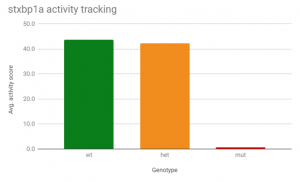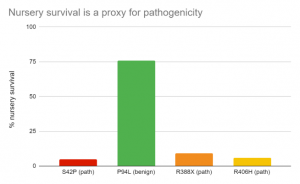We use the zebrafish (Danio rerio) as an in vivo model to measure the functional effects of patient-derived genetic variation. In this way, human genetic variants identified in the clinic are quantitatively and qualitatively connected to model animal phenotypes. As a proof of concept study, we used precision gene editing and transient knockdown approaches targeting stxbp1a – the zebrafish ortholog of human gene syntaxin-binding protein 1 (STXBP1) – to model variant genetic contributions to pediatric epilepsy and encephalopathy.
Syntaxin-binding protein 1 (STXBP1) is a protein involved in synaptic vesicle trafficking, and mutations in STXBP1 are implicated in childhood epilepsies and several neurodevelopmental disorders.
Stxbp1a is a highly conserved zebrafish ortholog of human STXBP1 (87% identity). Using CRISPR/Cas9 technology, we precisely generated a benign patient mutation at the conserved amino acid residue (CCC>CTG, p.P94L).
Zebrafish confirmed to recapitulate human phenotypes
Transient Stxbp1a Knockdown Recapitulates Mutant Phenotypes

Translation blocking morpholinos (AUG-MO) reproduce published stxbp1a null mutant phenotypes, including hyperpigmentation and failure to hatch.
Brightfield, 5 days post-fertilization1.
Neuronal Gene Expression is Altered in Stxbp1a Mutants & Morphants
 Pax2 expression is decreased in both stxbp1a mutants (center) and morphants (right) in central nervous system (CNS) tissues, indicating disrupted neuronal gene expression or tissue architecture.
Pax2 expression is decreased in both stxbp1a mutants (center) and morphants (right) in central nervous system (CNS) tissues, indicating disrupted neuronal gene expression or tissue architecture.
Epifluorescence, 5 days post-fertilization2.
Quantitative analysis of mutants recapitulates published Results
Stxbp1a Mutants Have Quantifiable Locomotor Deficits

Behavioral phenotyping can be used to characterize mutant and morphant phenotypes. Locomotion tracking data acquired with the NemaMetrix WMicroTracker shows that stxbp1a mutants do not swim and fail to hatch, recapitulating published results.1

- Grone, BP, et al. “Epilepsy, behavioral abnormalities, and physiological comorbidities in syntaxin-binding protein
1 (STXBP1) mutant zebrafish.” PLoS One 11.3 (2016): e0151148. - Hamada, N, et al. “MUNC18–1 gene abnormalities are involved in neurodevelopmental disorders through
defective cortical architecture during brain development.” Acta neuropathologica communications 5.1 (2017): 92.

